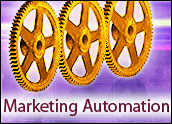
It’s understood by marketers that one of the most important ways they can differentiate their offerings in today’s unique selling environment is by creating a remarkable customer experience. One step toward achieving this goal is to ensure they have a single database that is tightly integrated with their CRM system to capture inbound and outbound dialogue and create a multidimensional marketing view of the customer.
However, marketers face some hurdles as the inbound and outbound dialogue between brands and their customers gets increasingly diluted and difficult to control. With so many more relationship channels (online/offline, traditional/emerging) that require personalization, it’s increasingly difficult for marketers to manage them. As a result, brands run the risk of diluting their messages and losing customers.
To solve this problem, marketers need a comprehensive, single solution to help automate and streamline their marketing programs and tailor them to individual customer lifecycles.
The right integrated inbound/outbound marketing strategy can help marketers create and manage powerful cross-selling marketing campaigns designed to provide the best customer experience possible.
Inbound vs. Outbound – Why Not Both?
Many times when companies claim that their campaigns are targeted or personalized, they are in fact referring only to outbound campaigns generated offline. Meanwhile, few companies are actually able to handle real-time inbound dialogues in a way that ensures that offers made are both personalized and consistent with outbound activities.
This is often because the company cannot leverage customer data across other outbound channels — or any data at all from its inbound marketing campaigns — in the absence of a single, centralized data repository. Instead, it uses basic predefined business/marketing rules to determine cross-sells, up-sells and hit or miss “latest offer” pushes.
By leveraging cross-channel customer data for inbound communications, organizations open up new opportunities for new sales and improved customer relationships that often can’t be accomplished through outbound communications alone.
For example, a targeted offer presented during a customer-initiated (inbound) contact via the Web, call-center, point-of-sale or ATM is two to three times as likely to convert as an offer made via targeted outbound campaigns — and around 15 times more likely than with untargeted outbound campaigns.
Marketers must strive to gain real-time access to an up-to-the-minute single marketing view of the customer — one comprised of cross-channel inbound/outbound offer history, complete interaction history (including Web analytics), demographics, sociographics, and both expressed and preferred interaction behaviors.
This also means going beyond integrating outbound campaigns across channels to integrating both outbound AND inbound communications across channels, so that all campaigns are based on the same complete set of customer data.
Cross-Channel Marketing Effectiveness
Ensuring a consistent, positive customer experience with a brand — no matter what channel of communication is being used — poses an ongoing challenge for marketers. Take email for example.
While batch email marketing campaigns may have some level of personalization, such as contacting customers in a particular geography about a sale at regional retail outlets, these communications quickly lose their personal touch when they don’t incorporate past interactions with the customer across other channels, such as direct mail or mobile.
To make matters worse, these outbound campaigns and the customer information they derive are often disconnected from any inbound communications with customers when they proactively seek information or make purchases.
Automating Inbound and Outbound Communications
Many marketing automation solutions today are unable to connect inbound and outbound campaigns across channels because they are simply a bundle of separately conceived applications that have been knitted together. Often, they present multiple user interfaces and use separate databases per channel which create more silos.
Fortunately, the latest marketing automation technology offers a single platform that can enable the unification of inbound/outbound campaigns by leveraging a single cross-channel customer view through a centralized database of customer information. By tightly integrating this single platform with a powerful CRM system, marketers are able to capture and analyze all inbound and outbound communications to get an unprecedented, holistic view of the customer’s buying behavior.
Today’s best-of-breed marketing automation software is able to evaluate a database of hundreds of current offer possibilities and select and present relevant ones in “real-time” during the inbound customer interaction, whether it occurs via the Web site, or call center or at point-of-sale. It also can select from and interface with outbound channels to deliver timely, personalized follow-up offers (i.e. sending an offer by email as a follow-up to the customer contacting the call center or browsing the Web site).
Marketing automation allows marketers to better manage relationship channels to ensure messages are communicated effectively across all customer touch points.
Most importantly, implementing a solution that can integrate inbound and outbound communications allows marketers to offer an unprecedented customer experience. And as we all know, implementing a good customer experience is the key to marketing effectiveness.
Kristin Hambelton is senior director of marketing at Neolane, a provider of enterprise marketing software.













































